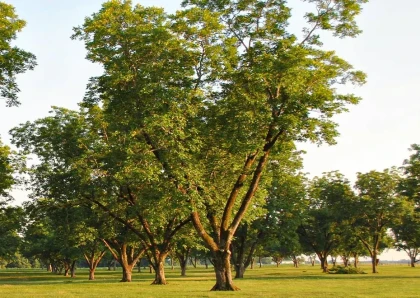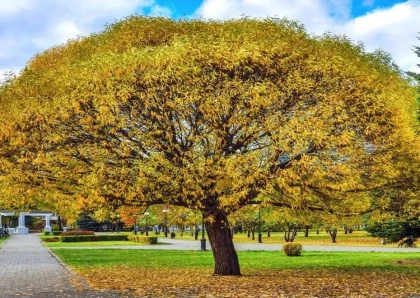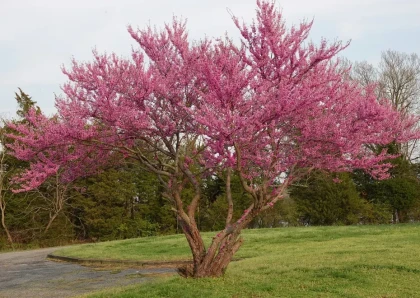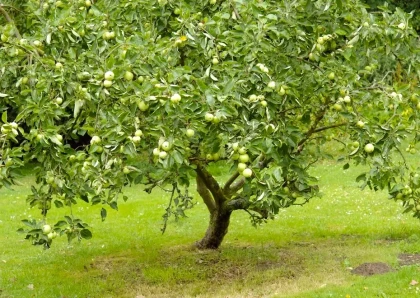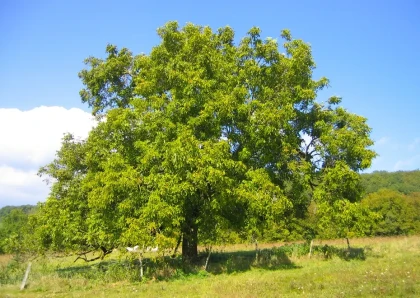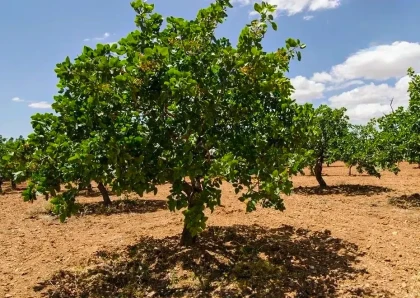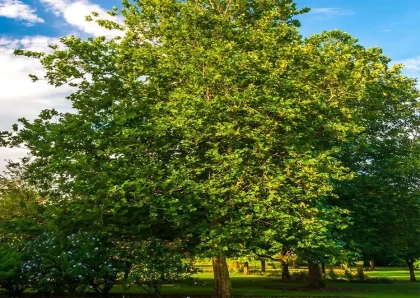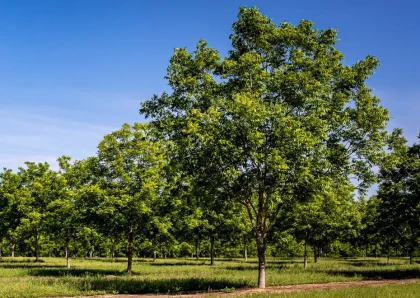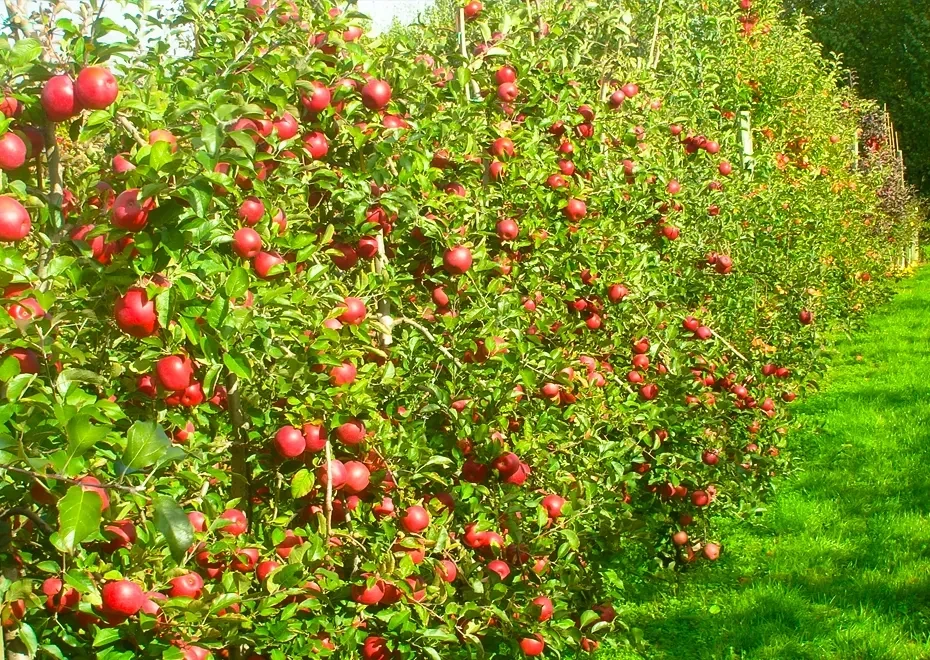
Aztec Fuji Apple Tree
Overview
History of the Tree
The Aztec Fuji Apple Tree is a modern apple variety developed through careful breeding and selection. It is a cross between the traditional Fuji apple and another apple variety, resulting in a unique and exceptional apple tree. The Aztec Fuji variety was specifically bred to enhance the desirable qualities of the Fuji apple while adapting to different growing conditions.
Detailed Description of the Tree
The Aztec Fuji Apple Tree is a medium-sized deciduous tree known for its vigorous growth and appealing appearance. It typically reaches a height of 12 to 15 feet (3.7 to 4.6 meters) with a spread of 8 to 10 feet (2.4 to 3 meters). The tree has a well-rounded shape and dense foliage, providing an attractive landscape feature.
The leaves of the Aztec Fuji Apple Tree are oval-shaped and glossy, displaying a vibrant green color during the growing season. In spring, the tree produces delicate pink blossoms that gradually transition into small, green fruit. As the fruit matures, it develops a beautiful red blush, offering a visually appealing contrast against the deep green leaves.
Types of This Tree
The Aztec Fuji Apple Tree is a specific cultivar within the Fuji apple family. As a result of careful breeding, this variety has been selected for its improved qualities, including taste, texture, and disease resistance. While there are no distinct types of Aztec Fuji apple trees, they are often categorized under the umbrella of Fuji apple varieties.
Importance of This Tree
The Aztec Fuji Apple Tree holds several important qualities:
- Exceptional Flavor: The apples of the Aztec Fuji variety are known for their outstanding taste. They offer a perfect balance of sweetness and tartness, with a crisp and juicy texture that makes them enjoyable for fresh eating, baking, and cooking.
- Extended Harvest Season: One of the significant advantages of the Aztec Fuji Apple Tree is its ability to extend the apple harvest season. It typically ripens in mid to late fall, allowing for a longer period of apple enjoyment.
- Disease Resistance: The Aztec Fuji variety has been bred to exhibit resistance to common apple diseases, such as apple scabs and powdery mildew. This resistance helps ensure the tree's health and productivity, reducing the need for excessive pesticide applications.
How to Care for This Tree
Proper care is essential to promote the healthy growth and productivity of the Aztec Fuji Apple Tree:
- Plant the tree in a location that receives full sunlight, as it requires at least 6 to 8 hours of direct sunlight daily for optimal fruit production.
- Ensure the soil is well-drained and fertile, as good soil conditions provide the necessary nutrients for the tree's growth. Conduct a soil test to determine any necessary amendments.
- Water the tree regularly, especially during dry spells, to keep the soil consistently moist but not waterlogged. Adequate moisture is crucial for fruit development and overall tree health.
- Apply a layer of organic mulch around the base of the tree, extending to the drip line. Mulch helps conserve moisture, suppress weeds, and regulate soil temperature.
- Prune the tree during the dormant season to maintain its shape, remove dead or damaged branches, and improve airflow within the canopy. Pruning also aids in fruit production and disease prevention.
- Monitor for common apple pests, such as aphids, codling moths, and apple maggots. Take appropriate measures, such as using organic insecticides or pheromone traps, to manage pest populations.
- Fertilize the tree annually with a balanced fruit tree fertilizer, following the manufacturer's instructions. Fertilization provides essential nutrients to support tree growth, flowering, and fruit development.
Benefits of the Tree
The Aztec Fuji Apple Tree offers several benefits:
- Delicious Apples: The fruit of the Aztec Fuji variety is highly regarded for its exceptional flavor. The apples are crisp, and juicy, and have a pleasing balance of sweetness and tartness, making them a popular choice for fresh eating and culinary uses.
- Extended Harvest: With the Aztec Fuji Apple Tree, you can enjoy a bountiful apple harvest for an extended period. The apples ripen in mid to late fall, providing a fresh supply of fruit for snacks, desserts, and preserving.
- Ornamental Value: In addition to its fruit-bearing capabilities, the Aztec Fuji® Apple Tree adds beauty to landscapes with its showy blossoms in spring and vibrant red apples hanging from the branches. It serves as both a functional and decorative tree.
How to Plant This Tree
Follow these steps to successfully plant an Aztec Fuji Apple Tree:
- Choose a planting location that receives full sunlight and has well-drained soil. The tree should have enough space to grow to its mature size.
- Dig a hole that is wider and slightly deeper than the root ball of the tree.
- Place the tree in the hole, ensuring that it is at the same level as or slightly above the ground surface. Avoid burying the graft union.
- Backfill the hole with soil, gently firming it around the roots to eliminate air pockets.
- Water the tree thoroughly after planting and continue to water regularly, especially during the first year, to aid in establishment.
Different Types of Wood Products That Can Be Made From
The wood of the Aztec Fuji Apple Tree, like other apple tree varieties, is not typically used for wood products due to its relatively small size and the preference for specialized hardwoods. However, apple wood can be utilized for small-scale woodworking projects, such as carving, turnings, and decorative crafts. It's fine grain and attractive light brown color can add aesthetic value to these creations.
Cons
While the Aztec Fuji Apple Tree has numerous advantages, there are a few considerations to keep in mind:
- Pollination Requirement: The Aztec Fuji variety requires cross-pollination with another apple tree of a compatible variety to ensure a proper fruit set. Planting a different apple variety nearby will help facilitate pollination and maximize fruit production.
- Climate Limitations: The Aztec Fuji Apple Tree performs best in regions with a suitable climate for apple cultivation. It may not thrive in areas with extremely hot or cold temperatures outside its recommended hardiness zone.
- Pest and Disease Management: While the Aztec Fuji variety exhibits good disease resistance, it is still susceptible to certain apple pests and diseases. Regular monitoring, proper sanitation, and appropriate pest management practices are necessary to protect the tree from potential issues.
FAQs
Q: Can I grow the Aztec Fuji Apple Tree in a container?
A: It is possible to grow the Aztec Fuji Apple Tree in a large container or pot, but keep in mind that the tree may not reach its full size or productivity potential. Container-grown apple trees require extra attention to watering, fertilizing, and root management.
Q: How long does it take for the Aztec Fuji Apple Tree to bear fruit?
A: The Aztec Fuji Apple Tree typically starts producing fruit within 2 to 4 years after planting, depending on various factors such as growing conditions and tree health. However, full fruit production may take a few more years to establish.
No listings available
Related Products
Questions & Answers
What do you want to know about this product?
Reviews (5)
AppleHarvestMaster99
A Fruitful Addition to My Orchard
The Aztec Fuji® Apple Tree has been a game-changer in my orchard. The apples are crisp, sweet, and perfect for both fresh eating and baking.
OrchardDynamo22
Juicy Apples Galore!
I'm thrilled with the Aztec Fuji® Apple Tree in my orchard. It produces an abundance of juicy apples with a delightful balance of flavors. Highly recommended!
FruitLoverGuru87
A Flavorful Harvest Every Year
The Aztec Fuji® Apple Tree has consistently delivered exceptional apples year after year. The fruit is aromatic, crisp, and bursting with sweetness. A top choice for any Apple enthusiast!
AppleEnthusiast123
Thriving and Delicious
I planted the Aztec Fuji® Apple Tree in my backyard, and it has flourished. The apples are absolutely delicious—crunchy, juicy, and full of flavor.
AppleMaestro094994
A Sweet Symphony of Apples
The Aztec Fuji® Apple Tree has become the star of my garden. Its apples are like a symphony of sweetness, making them a true delight for apple lovers. Simply amazing!





